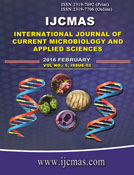


 National Academy of Agricultural Sciences (NAAS)
National Academy of Agricultural Sciences (NAAS)

|
PRINT ISSN : 2319-7692
Online ISSN : 2319-7706 Issues : 12 per year Publisher : Excellent Publishers Email : editorijcmas@gmail.com / submit@ijcmas.com Editor-in-chief: Dr.M.Prakash Index Copernicus ICV 2018: 95.39 NAAS RATING 2020: 5.38 |
Wound infection is one of the health problems that is caused and aggravated by the invasion of pathogenic organisms. Information on local pathogens and sensitivity to antimicrobial agent is crucial for successful treatment of wounds. So the present study was conducted to determine antimicrobial susceptibility pattern of bacterial isolates from wound infection and their sensitivity to antimicrobial agents. The study was carried out from Jan 2015 to July 2015 in a tertiary care centre located in remote settings of Mewat. Wound swabs and pus samples were processed in the diagnostic microbiology laboratory immediately on reception following standard guidelines. The antibiotic sensitivity testing of all isolates was performed by Kirby Bauer’s disc diffusion method and interpreted as per CLSI guidelines. Analysis of 438 pus samples showed 72.6% culture positivity with Surgical wards (39.7%) being the major contributor. Out of positive samples 82.3% were mono microbial and 17.7% poly microbial. Staphylococcus aureus (24.2%) was the most common organisms followed by, Pseudomonas (21.4%), E coli (14.8%), Proteus spp (8.8%), Citrobacter spp (8.2%), Enterococcus (6.6%), Klebsiella spp (6.1%) and Streptococcus (2.2%). Incidence of MRSA was 48.9% and 42.8% respectively. ESBL among Enterobactericeae were noted. Percentage resistance of isolates to individual antibiotic was also noted. The changing trends of antimicrobial susceptibility in bacterial isolates from pus can serve as a useful tool for physicians to start empirical treatment of patients at the earliest according to the geographical areas and emerging multi-resistant bacteria.
 |
 |
 |
 |
 |